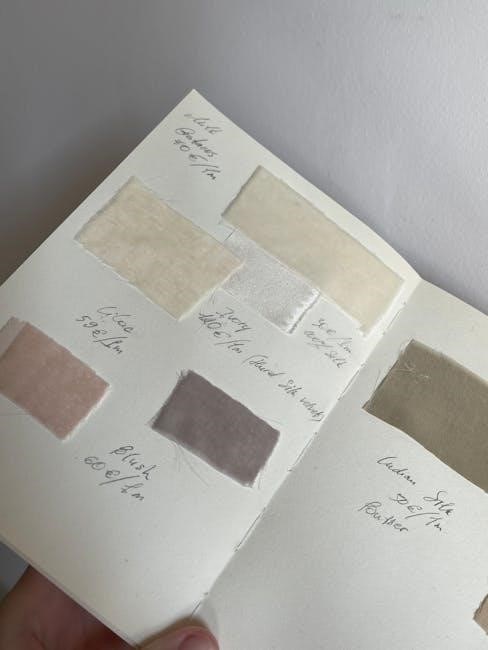Fabric weight is a critical factor in textile selection, influencing durability, comfort, and suitability for specific applications. Understanding the fabric’s weight helps determine its best use.
Why Fabric Weight Matters
Fabric weight plays a vital role in determining a textile’s durability, comfort, and suitability for specific applications. Lighter fabrics offer breathability and flexibility, ideal for summer clothing, while heavier ones provide structure and warmth, perfect for winter wear. The weight also influences the fabric’s drape and stability, affecting how it behaves during sewing and use. Understanding fabric weight ensures you choose the right material for your project, balancing aesthetics and functionality. Whether for upholstery, apparel, or home decor, the weight of the fabric directly impacts its performance and longevity, making it a crucial factor in any textile selection.
Understanding Fabric Density
Fabric density refers to how tightly the fibers are packed within the material, influencing its overall weight and performance. Denser fabrics are heavier and more durable, while less dense fabrics are lighter and more breathable. Density is determined by the weave, thickness of yarns, and type of fibers used. It directly impacts the fabric’s drape, stability, and resistance to wear. Higher density fabrics, like those used in upholstery, offer structure and longevity, while lower density fabrics, such as chiffon, provide a soft, airy texture. Understanding fabric density helps in selecting materials that meet specific functional and aesthetic requirements for various projects.

Definition and Measurement of Fabric Weight
Fabric weight refers to the heaviness of a textile, measured in grams per square meter (GSM) or ounces per square yard (oz/yd²). It determines material thickness and durability.
Grams per Square Meter (GSM)
Grams per square meter (GSM) measures fabric weight by calculating the weight of one square meter of material. Common ranges include lightweight fabrics like cotton (100-200 GSM) and heavier options like canvas (400-500 GSM). This metric helps determine fabric density and thickness, crucial for sewing, upholstery, or crafting. Higher GSM indicates heavier, more durable fabric, while lower GSM suits delicate projects. Understanding GSM ensures proper material selection for desired durability and comfort, making it a vital factor in textile choice for various applications.

Ounces per Square Yard (oz/yd²)
Ounces per square yard (oz/yd²) is an imperial measurement for fabric weight, commonly used in the United States. It represents the weight of one square yard of fabric in ounces. This system is particularly useful for comparing fabrics across different projects, ensuring the material’s weight aligns with its intended use. For example, lightweight fabrics like voile or chiffon typically range from 2-4 oz/yd², while heavier fabrics like canvas or denim may exceed 8 oz/yd². Understanding oz/yd² helps in selecting fabrics that meet specific durability and comfort requirements for sewing, upholstery, or crafting.

Fabric Weight Categories
Fabric weight is categorized into lightweight, medium-weight, and heavyweight, each suited for different applications. These categories help in selecting fabrics based on their intended use and durability requirements.
Lightweight Fabrics
Lightweight fabrics are ideal for summer clothing and delicate projects. They typically range from 2.5 to 6 ounces per square yard or 70 to 150 grams per square meter. These fabrics, such as voile, chiffon, and lawn, are breathable, offering comfort in warmer weather. Their sheer texture makes them perfect for flowing dresses, blouses, and curtains. However, their thin nature can make them less durable and more prone to wrinkling. Choosing the right lightweight fabric ensures a balanced combination of style and functionality for seasonal or decorative purposes.
Medium-Weight Fabrics
Medium-weight fabrics strike a balance between durability and comfort, typically weighing 7 to 14 ounces per square yard or 200 to 400 grams per square meter. Fabrics like denim, twill, and canvas fall into this category. They are versatile and suitable for a wide range of applications, from workwear to upholstery. Medium-weight fabrics offer structure while remaining breathable, making them ideal for jackets, pants, and home decor. Their adaptability across seasons and uses ensures they are a practical choice for both functional and stylish projects, providing a reliable middle ground between lightweight and heavyweight options.
Heavyweight Fabrics
Heavyweight fabrics are robust and durable, typically weighing over 14 ounces per square yard or 400 grams per square meter. These fabrics, such as canvas, denim, and tweed, are ideal for heavy-duty applications like upholstery, winter coats, and outdoor gear. Their dense construction provides excellent insulation and structure, making them perfect for projects requiring strength and longevity. Heavyweight fabrics are often used in cold-weather clothing and home decor, offering both functionality and a sturdy aesthetic; Their thickness and stability ensure they hold up well under stress, making them a practical choice for demanding environments and long-lasting creations.
Seasonal Considerations for Fabric Weight
Seasonal considerations influence fabric weight choices, with lightweight fabrics like cotton and linen ideal for summer, and heavyweight fabrics such as wool and denim suited for winter.
Summer Fabrics: Lightweight Options
Summer fabrics prioritize breathability and comfort, making lightweight options ideal for warm weather. Materials like cotton, linen, and rayon are popular choices due to their natural cooling properties. Lightweight fabrics typically range from 100 to 200 GSM, offering a soft, airy texture that drapes well and allows moisture to evaporate quickly. These fabrics are perfect for garments like dresses, tops, and shorts, where comfort and flexibility are essential. The lighter weight also reduces heat retention, ensuring wearers stay cool during the summer months. Opting for these fabrics ensures a balance between style and functionality for seasonal apparel.
Winter Fabrics: Heavyweight Options
Winter fabrics are designed for warmth and durability, typically made from heavyweight materials like wool, fleece, and thick cotton. These fabrics usually range from 250 to 400 GSM, offering excellent insulation and structure. Heavyweight fabrics are ideal for outerwear, coats, and blankets, as they retain heat effectively and withstand harsh weather conditions. Their dense weave and thick fibers provide durability, making them suitable for long-lasting winter garments. While heavier fabrics may lack the drape of lighter materials, they compensate with superior warmth and resilience, ensuring comfort and protection during colder months.
Fabric Type and Weight
Fabric weight varies significantly by type, with natural fibers like cotton and linen offering versatility, while synthetic blends like polyester provide durability and consistent weight.

Cotton, Polyester, and Blends
Cotton fabrics are breathable and soft, typically ranging from 150 to 300 GSM, making them ideal for summer clothing and light upholstery. Polyester, known for its durability, often weighs between 200 to 400 GSM, suitable for outdoor and heavy-duty applications. Blends, like cotton-polyester mixes, combine the natural feel of cotton with polyester’s strength, offering balanced weight and versatility. These fabrics are widely used in apparel, upholstery, and industrial textiles due to their adaptability and consistent performance across various weights and uses.
Linen, Rayon, and Silk

Linen, made from flax, is a lightweight, breathable fabric ideal for summer. Its weight typically ranges from 150 to 250 GSM, offering a crisp texture and loose weave. Rayon, a semi-synthetic fiber, mimics natural fabrics like silk or cotton, with weights varying from 100 to 300 GSM, making it versatile for dresses and blouses. Silk, a luxurious natural fiber, is lightweight yet durable, often weighing between 80 and 150 GSM. These fabrics are prized for their unique textures, drape, and suitability for both casual and high-end garments, blending aesthetics with functionality across various seasons and applications.
Fabric Weave and Thickness
Fabric weave and thickness significantly impact weight. Tight weaves result in denser, heavier fabrics, while loose weaves create lighter materials. Fiber thickness also contributes to overall weight.
Impact of Weave on Weight
Fabric weave significantly affects weight. Tight weaves result in denser, heavier fabrics, while loose weaves create lighter materials. Twill and satin weaves balance weight and drape, offering medium-weight options. The arrangement of yarns in the weave determines how tightly the fabric is packed, influencing its overall weight and durability. Heavier weaves are ideal for structured garments, while lighter weaves suit flowing designs. Understanding the weave’s impact helps in selecting fabrics that meet specific project requirements, ensuring optimal performance and aesthetic appeal.
Fiber Thickness and Yarn Weight
Fiber thickness and yarn weight play a crucial role in determining fabric weight. Thicker fibers, like wool or denim, result in heavier fabrics, while finer fibers, such as silk or cotton, produce lighter textiles. Yarn weight, measured by its thickness and density, also influences the overall weight of the fabric. Heavier yarns create denser fabrics, suitable for durability and warmth, while lighter yarns yield softer, more delicate materials. The combination of fiber thickness and yarn weight directly impacts the fabric’s feel, drape, and performance, making it essential to consider these factors when selecting fabrics for specific projects or applications.

Conversion Between GSM and oz/yd²
Fabric weight can be converted using the factor 1 oz/yd² ≈ 33.906 gsm. To convert oz to gsm, multiply by 33.906; to convert gsm to oz, divide by 33.906.

How to Convert Fabric Weight
To convert fabric weight between GSM and oz/yd², use the conversion factor of 1 oz/yd² = 33;906 gsm. Multiply oz by 33.906 to get gsm, or divide gsm by 33.906 to get oz. For example, 6 oz/yd² equals 203 gsm (6 × 33.906), while 200 gsm equals approximately 5.9 oz/yd² (200 ÷ 33.906). This ensures accurate measurements for fabric selection, enabling seamless transitions between metric and imperial systems. Always use precise calculations to avoid errors in fabric weight comparisons and project planning.
Practical Examples of Conversion
Converting fabric weight is essential for ensuring compatibility with different measurement systems. For instance, if a fabric weighs 200 gsm, to find its weight in oz/yd², divide 200 by 33.906, resulting in approximately 5.9 oz/yd². Conversely, to convert 6 oz/yd² to gsm, multiply 6 by 33.906, yielding around 203 gsm. These examples demonstrate how simple arithmetic can provide accurate conversions. Always double-check calculations to ensure precision, as small errors can affect fabric selection and project outcomes. Using a conversion chart or calculator can streamline this process for consistent results.


